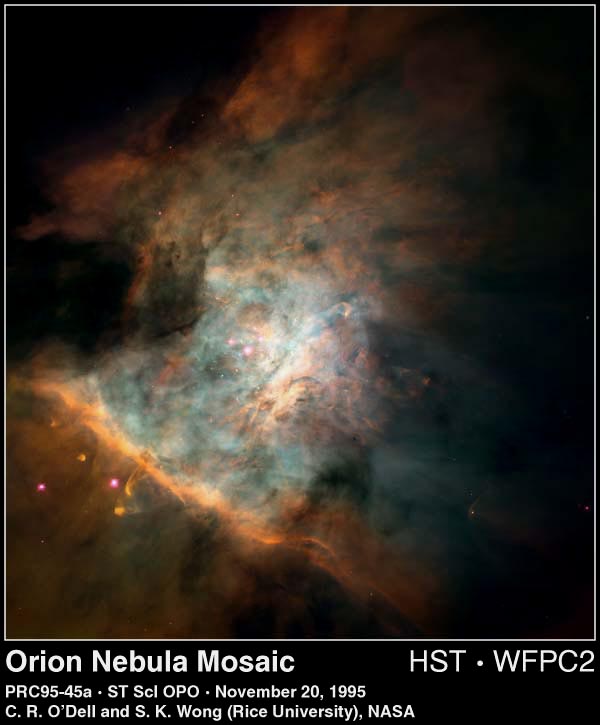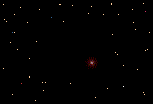
The main Orion Molecular Cloud
is 100,000 times more massive than the Sun. It's density, 1000
particles per cubic centimeter in the outer limits at which the cloud is
visible to us, increases towards the center where the cloud may actually be
as dense as 106 particles
per cubic centimeter. This is still billions of times less dense than our
Earth's atmosphere, and 1016
less dense than the star that may eventually form. Most of the cloud is
molecular hydrogen, though the cloud is best studied by trace amounts of the
molecular carbon dioxide.
In the center of the Orion
Nebula, a region 2.5 light years wide and at 1,500 light
years from us, there is the Trapezium, four bright hot stars whose
ultraviolet light makes the Orion Nebula glow. The Trapezium stars are
relatively young, about 100,000 years old. Seven hundred other young
stars are also present. One can see shock waves, caused by jets of hot gas
given off by some of these stars, and protoplanetary disks ("proplyds"),
discovered by the Hubble Space Telescope, that seem to be solar
systems in formation. Chandra's X-ray telescope scientists
found stars emitting not only at
temperatures of 5 to
10 million 0C, typical of
stellar coronas, but also at temperatures of 60 million
0C.
The Orion region, with its active
ongoing star formation, is an exciting observing direction for all
technologies.

This spectacular color panorama of the center the Orion nebula is one of
the largest pictures ever assembled from individual images taken with NASA's
Hubble Space Telescope. The picture, seamlessly composited from a mosaic of
15 separate fields, covers an area of sky about five percent the area
covered by the full Moon.
The seemingly infinite tapestry of rich detail revealed by Hubble shows a
churning turbulent star factory set within a maelstrom of flowing,
luminescent gas. Though this 2.5 light-years wide view is still a small
portion of the entire nebula, it includes almost all of the light from the
bright glowing clouds of gas and a star cluster associated with the nebula.
Hubble reveals details as small as 4.1 billion miles across.
Hubble Space Telescope observing time was devoted to making this panorama
because the nebula is a vast laboratory for studying the processes which
gave birth to our own Sun and solar system 4.5 billion years ago. Many of
the nebula's details can't be captured in a single picture - any more than
one snapshot of the Grand Canyon yields clues to its formation and history.
Like the Grand Canyon, the Orion nebula has a dramatic surface topography --
of glowing gasses instead of rock -- with peaks, valleys and walls. They are
illuminated and heated by a torrent of energetic ultraviolet light from its
four hottest and most massive stars, called the Trapezium, which lie near
the center of the image.
In addition to the Trapezium, this stellar cavern contains 700 hundred other
young stars at various stages of formation. High-speed jets of hot gas
spewed by some of the infant stars send supersonic shock waves tearing into
the nebula at 100,000 miles per hour. These shock waves appear as thin
curved loops, sometimes with bright knots on their end (the brightest
examples are near the bright star at the lower left).
The mosaic reveals at least 153 glowing protoplanetary disks (first
discovered with the Hubble in 1992, and dubbed "proplyds") that are believed
to be embryonic solar systems that will eventually form planets. (Our solar
system has long been considered the relic of just such a disk that formed
around the newborn Sun). The abundance of such objects in the Orion nebula
strengthens the argument that planet formation is a common occurrence in the
universe. The proplyds that are closest to the Trapezium stars (image
center) are shedding some of their gas and dust. The pressure of starlight
from the hottest stars forms "tails" which act like wind vanes pointing away
from the Trapezium. These tails result from the light from the star pushing
the dust and gas away from the outside layers of the proplyds. In addition
to the luminescent proplyds, seven disks are silhouetted against the bright
background of the nebula. These dark objects allow Hubble astronomers to
estimate the masses of the disks as at least 0.1 to 730 times the mass of
our Earth.
Located 1,500 light-years away, along our spiral arm of the Milky Way, the
Orion nebula is located in the middle of the sword region of the
constellation Orion the Hunter, which dominates the early winter evening
sky, at northern latitudes. The stars have formed from collapsing clouds of
interstellar gas within the last million years. The most massive clouds have
formed the brightest stars near the center and these are so hot that they
illuminate the gas left behind after the period of star formation was
complete. The more numerous faint stars are still in the process of
collapsing under their own gravity, but have become hot enough in their
centers to be self luminous bodies.
Technical information: To create this color mosaic, 45 separate images of
the Orion nebula were taken in blue, green and red between January 1994 and
March 1995. Light emitted by oxygen is shown as blue, hydrogen emission is
shown as green, and nitrogen emission as red light. The overall color
balance is close to that which an observer living near the Orion nebula
would see. The irregular borders produced by the HST images have been
smoothed out by the addition of images from the European Southern
Observatory in Chile obtained by Bo Reipurth and John Bally, these being
about 2% of the area shown here and lying at the top left corner.
Credit: C.R. O'Dell (Rice University), and NASA



